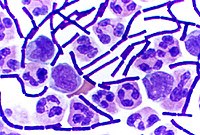
Photo from wikipedia
Abstract In the present study, optimization of Kraft lignin (KL) decolorization and degradation were carried out using an isolated ligninolytic bacterial strain Bacillus velezensis. The process was optimized using Central… Click to show full abstract
Abstract In the present study, optimization of Kraft lignin (KL) decolorization and degradation were carried out using an isolated ligninolytic bacterial strain Bacillus velezensis. The process was optimized using Central Composite Design (CCD) through Response Surface Methodology (RSM) for four variables i.e. carbon, nitrogen as nutritional parameters and temperature, pH as physical parameters while monitoring two response (% color removal and degradation). Under optimal conditions, the maximum KL decolorization and degradation capacity of strain was 56.16 % and 40.39 %, respectively. The pulp paper mill effluent toxicity was assessed in terms of phytotoxicity measurement on Phaseolus aureus. The germination percentage of Phaseolus aureus in wastewater treated with bacterial strain was 70 %, while untreated sample showed 50 % only.
Journal Title: Journal of environmental chemical engineering
Year Published: 2020
Link to full text (if available)
Share on Social Media: Sign Up to like & get
recommendations!